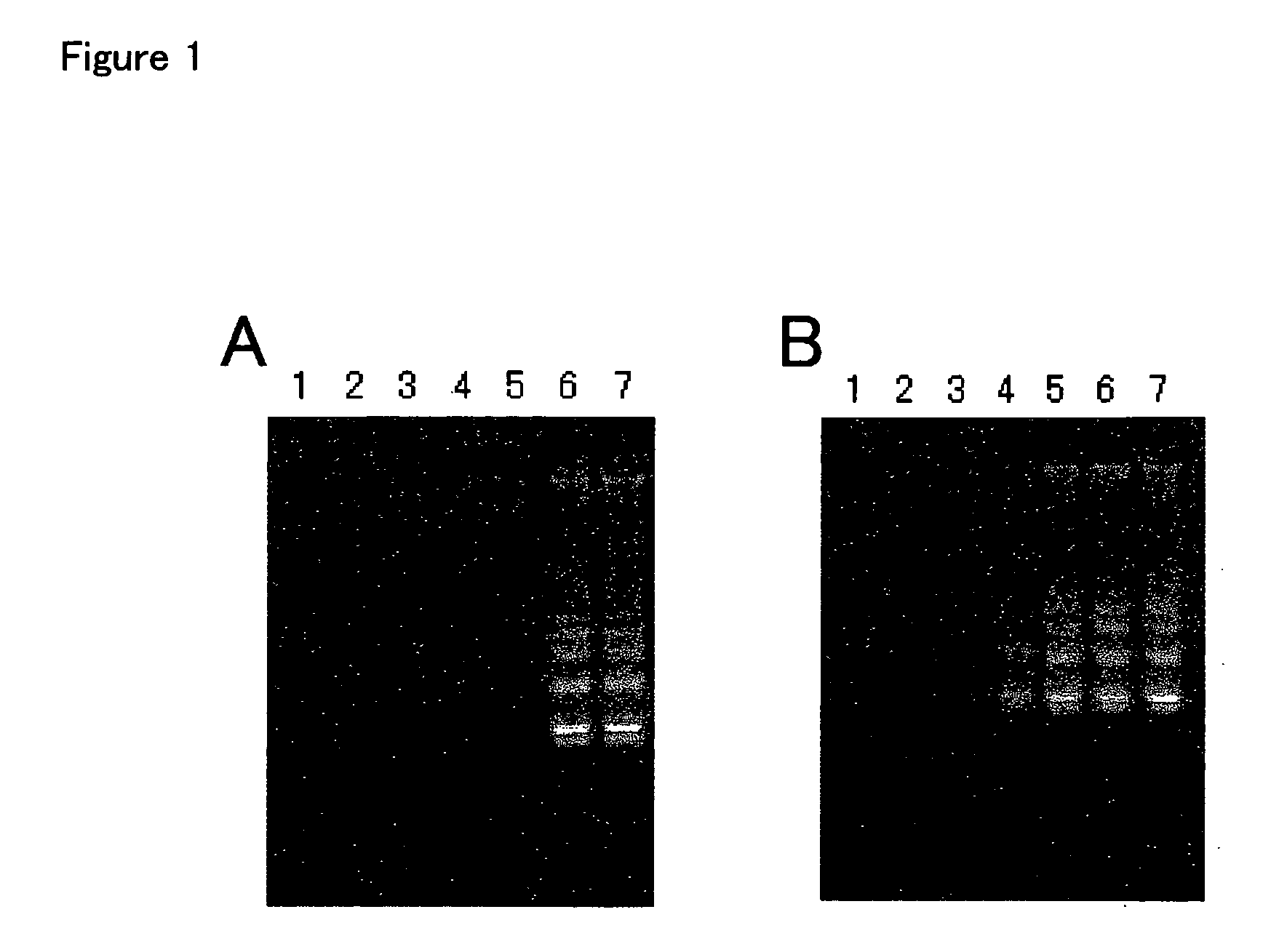Nucleic and amplification methods
a nucleic acid and amplification technology, applied in the field of target nucleic acid amplification, can solve the problems of serious running cost associated with the use of modified deoxyribonucleotide triphosphate, abolish the cleavage of amplified dna fragments with restriction enzymes, and use of expensive thermal cyclers, etc., to facilitate the detection of target nucleic acids, shorten the time, and increase the sensitivity of detecting target nucleic acid
- Summary
- Abstract
- Description
- Claims
- Application Information
AI Technical Summary
Benefits of technology
Problems solved by technology
Method used
Image
Examples
referential example 1
Cloning of RNase HII Gene from Archaeoglobus fulgidus
[0164] (1) Preparation of Genomic DNA from Archaeoglobus fulgidus
[0165] Cells of Archaeoglobus fulgidus (purchased from Deutsche Sammlung von Mikroorganismen und Zellkulturen GmbH; DSM4139) collected from 8 ml of a culture was suspended in 100 .mu.l of 25% sucrose, 50 mM tris-HCl (pH 8.0). 20 .mu.l of 0.5 M EDTA and 10 .mu.l of 10 mg / ml lysozyme chloride (Nacalai Tesque) in water was added thereto. The mixture was reacted at 20.degree. C. for 1 hour. After reaction, 800 .mu.l of a mixture containing 150 mM NaCl, 1 mM EDTA and 20 mM tris-HCl (pH 8.0), 10 .mu.l of 20 mg / ml proteinase K (Takara Shuzo) and 50 .mu.l of 10% aqueous solution of sodium lauryl sulfate were added to the reaction mixture. The mixture was incubated at 37.degree. C. for 1 hour. After reaction, the mixture was subjected to phenol-chloroform extraction, ethanol precipitation and air-drying, and then dissolved in 50 .mu.l of TE to obtain a genomic DNA solution.
[0...
example 1
[0186] (1) Design of Primers and Block Oligonucleotides
[0187] A combination of a chimeric oligonucleotide primer and an upstream block oligonucleotide which is capable of annealing to an arbitrary portion 3' to a portion in a nucleic acid as a template to which the primer anneals was examined. First, chimeric primers for detecting Chlamydia trachomatis plasmid DNA, CT-BF19-3 (SEQ ID NO:6) and CT-BR23-2 (SEQ ID NO:7) were synthesized based on the nucleotide sequence of Chlamydia trachomatis plasmid (GenBank accession number X06707) using a DNA synthesizer. Additionally, upstream block oligonucleotides, CR-FBK (SEQ ID NO:8) and CR-RBK (SEQ ID NO:9), which have nucleotide sequences of Chlamydia trachomatis plasmid DNA and are capable of annealing to arbitrary portions 3' to portions in the nucleic acid as the template to which the chimeric oligonucleotide primers anneal, were synthesized. The upstream block oligonucleotides are blocked at the 3' termini by amination such that an extens...
PUM
| Property | Measurement | Unit |
|---|---|---|
| optimal growth temperature | aaaaa | aaaaa |
| temperature | aaaaa | aaaaa |
| temperature | aaaaa | aaaaa |
Abstract
Description
Claims
Application Information
 Login to View More
Login to View More - R&D
- Intellectual Property
- Life Sciences
- Materials
- Tech Scout
- Unparalleled Data Quality
- Higher Quality Content
- 60% Fewer Hallucinations
Browse by: Latest US Patents, China's latest patents, Technical Efficacy Thesaurus, Application Domain, Technology Topic, Popular Technical Reports.
© 2025 PatSnap. All rights reserved.Legal|Privacy policy|Modern Slavery Act Transparency Statement|Sitemap|About US| Contact US: help@patsnap.com

